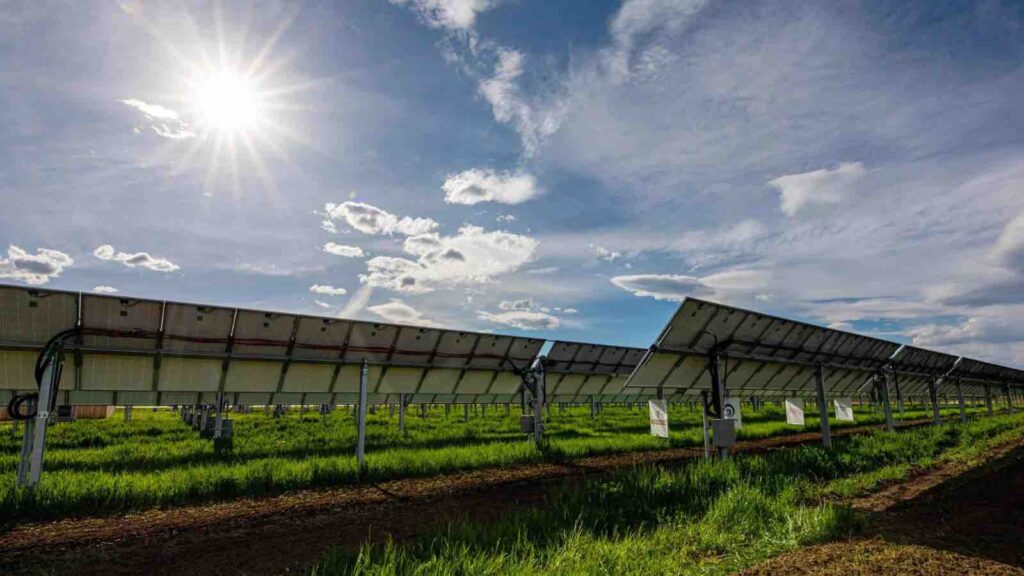Can agrivoltaics be a win – win? An experimental melding of agriculture and renewable power production could help a nation meet its growing food and energy needs simultaneously.
On a sweltering afternoon in rural West Java, waves of heat rose from newly installed rows of solar panels, shimmering above stretches of lush green rice paddies and vegetable plots.
This dual-use “agrivoltaics” farm is among the first of its kind in Indonesia, an experimental melding of agriculture and renewable power production that could help the island nation meet its growing food and energy needs simultaneously.
RELEVANT SUSTAINABLE GOALS



Harnessing the Synergy of Sun and Soil for a Sustainable Future
“We’re harvesting two crops on the same land,” said Deden Rusamsi, the project manager for the plant operated by the state utility Perusahaan Listrik Negara (PLN). “It allows us to optimize every inch of available space.”
The integrated agricultural-photovoltaic concept, known as agrivoltaics, has gained traction globally as a potential solution for boosting sustainable food production while accelerating the green energy transition needed to curb climate change.
Agrivoltaics In Indonesia
On the sun-baked expanses of Indonesia’s most populous island Java, agrivoltaics could offer a path to overcoming land constraints that have stymied growth in both solar energy and agriculture. The country’s clean energy targets call for installing over 30 gigawatts of solar power by 2030, while feeding its population of 270 million requires preserving ever more precious arable land.
The West Java agrivoltaics farm, covering just a few acres, offers an early glimpse at how dual-use renewable agriculture might work at scale. Crops like chilies, spinach and rice varieties optimized for shade tolerance thrive in the diffused sunlight beneath elevated solar arrays. Farmers tend to the plantings while technicians monitor the photovoltaic system’s output.
“Finding that perfect balance between the two systems is a perpetual calibration,” said Mr. Rusamsi. “But the results so far have been more than double what we could achieve with either pursuit alone.”
Across Asia, the marriage of agriculture and solar infrastructure is emerging as a promising avenue to maximize limited land resources for both food and energy production — key national priorities as economies modernize and populations expand.

The Bright Promise of Agrivoltaics in Asia
Southeast Asian nations like Indonesia and the Philippines, blessed with abundant year-round sunshine but lacking available land, are seen as prime candidates for wider agrivoltaics adoption. Yet so far, large-scale implementations have been limited as governments and agricultural interests weigh challenges like tailoring crop selection to each site.
“It’s an elegant solution on paper, but the technical complexities are immense in practice,” said Saurabh Kumar, a renewable energy engineer who has studied agrivoltaic designs. “Still, the pressure is only growing for countries to produce more energy and food with less land. And agrivoltaics may be one of our best options moving forward.”
At the West Java site, researchers are meticulously tracking the growth rates, yields and sunlight exposure of a rotating array of vegetable, grain and root crops. Agronomists analyze soil nutrients and optimize plant varieties to thrive in the partial shade.
If it succeeds, the pilot project could catalyze a national wave of agrivoltaics farms designed to blanket the country’s limited agricultural areas with interwoven networks of food crops and solar panels.
“We need major investments in renewable power, but we must safeguard our food security as well,” said Djenal Rosyidin, director of operations for PLN in West Java. “This dual-harvest approach could be the answer for efficiently meeting both needs at once.”
You may also be interested in :
Empowering The Next Generation: 2024 New Futures Fellowships By Planet Reimagined


